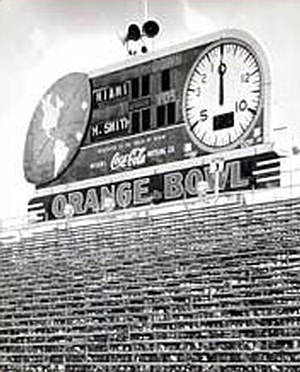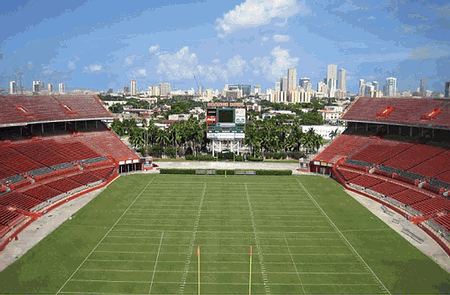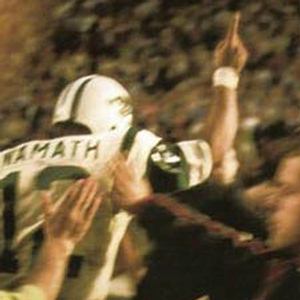

THE ORANGE
BOWL
GONE BUT NEVER FORGOTTEN
|
|
The Rose Bowl, “The Grand Daddy Of Them All” when referring to college bowl games was an institution by the 1920’s, one of the world’s most popular sporting events. From its inception in 1902, it was a hit with fans and participants alike but presenting a football contest on the Day of The New Year dated to years earlier when the University Of Chicago team of Amos Alonzo Stagg squared off against Stanford in a three game series, the finale being held in San Francisco on January 1, 1895. January 1, 1925 featured a capacity crowd Rose Bowl but that very busy day also saw huge attendance figures at the Penn vs. Cal game in Berkeley and in Honolulu where Hawaii shut out Colorado in front of the home folks. The administrators in a number of warm weather cities saw the potential for a New Year’s Day collegiate celebration that would bring in visitors and income. In 1933 the City Of Miami, Florida hosted the Palm Festival game and rejoiced as Miami defeated favored Manhattan College of New York City in a public park. In 1934 a repeat game was held as Miami fell to Duquesne but this set the precedent for an annual, permanent New Year’s Day contest. On January 1, 1935, the first officially recognized and named Orange Bowl Classic game pitted Bucknell against Miami.
.jpg) |
 |
The
University Of Miami presented a plan to officially introduce their football
program at the start of the 1927 season. The plan included an on-campus
stadium whose construction began on September 15, 1926. Tragically, a
devastating hurricane struck the area on the following day, resulting in 130
deaths, the destruction of the new stadium site, and the cessation of the
building plans. Miami football games were instead played on a field of coral
rock and mulch in what appeared to be temporary surroundings. Burdine
Stadium was built and named after City Of Miami pioneer Roddy Burdine as a
City Public Works project. Completed in December 1937, the University Of
Miami program was happy to be its occupant and played its first game there
on December 10, 1937. The first Orange Bowl Classic game was contested at
the stadium on January 1, 1938 and ran continuously until 1995. The original
stadium consisted of two sideline decks that provided seating for 23,330.
End zone seats were added in the 1940’s and an upper deck was added to the
sideline seats near the end of the 1950’s. Further expansion took place in
the 1960’s until a maximum capacity of 80,010 was reached. In 1959, the name
of the downtown edifice was officially changed to the Orange Bowl to reflect
its long association with the Bowl Classic. With the University Of Miami
program struggling on the field, the south Florida area received a shot in
the arm when the American Football League expanded and placed its new Miami
Dolphins into the Orange Bowl. On September 2, 1966, the Dolphins played
their first regular season game within the confines of the stadium that was
now adjacent to the Little Havana neighborhood as the demographics of the
City changed. The Dolphins run of success in the early-1970’s became one of
the highlights of the burgeoning popularity of the NFL and this placed the
Orange Bowl in a position of prestige, allowing its pro football association
to match its long time relationship with college football in the mind of the
national public. Between 1971 and ’75, the Dolphins set an NFL record of
thirty-one consecutive home game victories, including four playoff wins, on
their home field.
 |
This is not to say that college football fell by the wayside. The Orange Bowl Classic set a precedent by hosting the first college bowl game played at night. On January 1, 1971 Nebraska defeated LSU 17-12 in an action-packed game that in many ways changed the viewing habits of the entire nation. The night bowl game broadcast proved so popular that this became a standard, first for bowl presentation and in the following years, for all of college football. When the University Of Miami’s football fortunes rose and the ‘Canes dazzled spectators with their explosive play, their home field Orange Bowl became the site of the nation’s longest collegiate win streak. Between 1985 and 1994 “The U” notched fifty-eight consecutive home victories much to the chagrin of visiting opponents. The home field advantage enjoyed by both the Dophins and Hurricanes was often attributed to the stadium itself. With many of the seats extremely close to the field, the steel support structure, and what came to be seen as “old fashioned” backless metal bleachers, the sound level would at times be at Richter-Scale level and cacophonous as opposing quarterbacks attempted to call signals in a crucial situation. Goal line stands by the home team in the closed West End of the stadium were often the source of Monday morning comment in every nationally syndicated newspaper. Miami’s students became famous for stomping loudly on the steel decks, creating a din that reverberated from the stadium’s location at NW 3rd Street throughout downtown and often to the edge of the Atlantic Ocean. If a stadium that holds close to 80,000 individuals can be described as “intimate”, the Orange Bowl qualified, making it a favored venue for numerous rock and roll concerts through the decades. As the popularity of soccer rose in the region, it also became the site of the 1996 Summer Olympic soccer games. By that time unfortunately, the Dolphins had long-ago vacated their original home site for a new stadium in the suburbs.
.jpg) |
As immigrants from Cuba and other Latin American countries swelled Miami’s population, many middle and upper class families moved to the suburbs surrounding the city. Watching much of their fan base leave the inner city and downtown, the Dolphins organization moved also, to the Miami Gardens area, leaving the Orange Bowl to the University program. Joe Robbie Stadium began hosting Dolphins games in 1987 and on New Year’s Day 1997, the Orange Bowl Classic was moved from its namesake, to be played at the Dolphins home field, since renamed Dolphins Stadium. The disrespect shown toward the venerated site of so many great football games was not yet complete. The University Of Miami played its final home game at the Orange Bowl on November 10, 2007, perhaps fittingly losing to Virginia 48-0 in what was the program’s worst home loss ever. Florida International University used the Orange Bowl as its temporary home site for the 2007 season while its own home field underwent renovation and on December 1, 2007, they were the last collegiate team to walk off of the Orange Bowl field. The curtain fell for the last time on January 4, 2008 as the O-D All American Bowl High School All Star Game marked the end of football at the Orange Bowl. As the planned demolition of this grand palace of football began in March of 2008 some viewed its demise as a social issue, others as what they termed “a sporting issue.” A close friend Jose who lives just minutes away provided these poignant photos and mentioned: "Well there's about 1/4th left of the Orange Bowl. I saw what's left of it yesterday. Looks like a plane crashed into it. People set chairs just outside the gates daily and just stare......kinda like if they were at a wake."
.jpg) |
.jpg) |
The flight of many middle class patrons to the suburbs, perhaps due to the desire for a decrease in crime, better schools, and enhanced public services is seen as a major reason for the close of the Orange Bowl. Others cite the lack of amenities that have now become standard fare at almost every big city stadium, including seats with back support, luxury boxes, and improved parking facilities, all of which were lacking despite some improvements to the stadium. Comparing the 4000 available parking spaces at the Orange Bowl to the 25,000 at Dolphins Stadium eliminated any controversy for the corporate sponsors who funded the Orange Bowl Classic and perhaps to those at the University Of Miami in charge of the financial bottom line. For all of the discussion about the move of the Dolphins and Hurricanes, the cessation of the Bowl Classic at the original site, and the demolition of the stadium, nothing will replace discussion about the many exciting games that brought joy to so many. Among the thrilling contests, it is perhaps the series of Super Bowl games that were played within the confines of the Orange Bowl that stand out as their most important and long-lasting football memories. Five Super Bowls and among them, Super Bowl III, perhaps the most significant one of all, graced the Orange Bowl field.
The first Super Bowl was played at the Los Angeles Coliseum and while not yet called “The Super Bowl”, it was super as far as NFL supporters were concerned as Vince Lombardi’s Packers confirmed the superiority of the NFL, at least in the minds of most observers. On January 14, 1968, the Packers squared off with the Oakland Raiders and their “Eleven Angry Men” defense in Super Bowl II, Miami’s first chance to host the game. Most significant was Green Bay quarterback Bart Starr’s second consecutive game MVP Trophy and Lombardi’s “retirement” as the Packers head coach. With rumors filling the air waves and newspapers in the weeks leading up to Super Bowl II, the Packers remained focused enough to lead 16-7 at halftime. Guard Jerry Kramer addressed his teammates after the coaches had left the locker room and said, “Let’s win this one for the old man” inspiring the Pack to finish the day, and Lombardi’s last game as the Green Bay mentor, with a 33-14 victory. The excitement of watching Lombardi’s team again exercise its dominance over the American Football League and win a third consecutive championship title, paled to the hype of Super Bowl III. Again hosted by the Orange Bowl, the star attraction was Jets quarterback Joe Namath. During Super Bowl week, while having dinner with teammate Jim Hudson, the two Jets were joined by the Colts Lou Michaels and Dan Sullivan. Namath purposely avoided any conversation about the game but Michaels insisted that no matter what, the Colts would win because they had the legendary Johnny Unitas on their side. Backup Earl Morrall had actually guided the Colts to their superb season, with Unitas a victim of a severe elbow injury. Namath, who had worn Unitas’ number nineteen in high school and admired the great “Johnny U.” so much that his Beaver Falls’ hometown nickname was “Joey U.”, questioned Michaels’ assessment and further said, “We both know Johnny can’t throw across the street right now. His arm hurts; he’s got a bad arm.” He finished his statement with the pronouncement “Besides that, Lou, what the heck do you know? You’re nothing but a damn kicker.” While this exchange incited Michaels and his Colts teammates, one night later Namath’s retort to a heckler who doubted the Jets ability to stay on the field with the powerful Colts was “I got news for you. We’re going to win the game. I guarantee it.” This has been, perhaps the most famous “guarantee” in pro football history and to the credit of the Jets players and coaches, they did in fact upset the mighty Colts 16-7, even as the injured Unitas came off the bench to replace Morrall. This “AFL victory over the NFL” was ground-breaking as well as earth-shattering, confirming for many the acceptance of the merger of the two leagues and the perception that there was more parity between the warring factions than may have been evident.
.jpg) |
 |
The January 17, 1971 Super Bowl V that has often been cited as a conglomeration of errors won on a last second field goal by Colts receiver Jim O’Brien, was actually a hard-hitting contest that saw both teams forced into errors. Surprisingly, linebacker Chuck Howley walked away with the MVP award despite playing for the Dallas Cowboys who were on the wrong end of the 16-13 score. This was the only time that a player from the losing side won the award. The game also marked the first Super Bowl game played on artificial turf and despite the game’s ten turnovers, the Colts, this time with Morrall coming off of the bench to substitute for an injured Unitas, were able to finally eliminate the shadow cast over them from their loss in Super Bowl III. On January 18, 1976 the Super Bowl returned to the Orange Bowl for its tenth incarnation. Featuring a Pittsburgh Steelers team that was loaded with future Pro Football Hall Of Fame members, they faced off with a wild card Cowboys squad. With MVP Lynn Swann playing in spectacular fashion, the Steelers found themselves hanging on with a narrow 21-17 lead as the Cowboys took the football for one final, desperate drive with only 1:22 on the clock and no timeouts remaining in their possession. Dallas quarterback Roger Staubach pushed his offense to the Steelers’ thirty-eight yard line and as time was running out, launched a pass toward the end zone. Pittsburgh defensive back Glen Edwards intercepted to give the Steelers their second consecutive Super Bowl victory.
.jpg) |
In what would be its last reception of a Super Bowl, the Orange Bowl again
hosted the Steelers and Cowboys on January 21, 1979 in SB XIII. In this
first rematch of Super Bowl competitors, Terry Bradshaw had a wonderful
outing, passing for 318 yards and four touchdowns. Behind by 21-14 in the
third quarter, the Cowboys’ Pro Football Hall Of Fame tight end Jackie
Smith, thrilled to be part of a Super Bowl team after years with the
mediocre Cardinals, attempted to catch what appeared to be an under thrown
pass as he stood uncovered in the end zone. Widely blamed for a “drop” that
has become a staple in Super Bowl blooper conversation, Smith watched a
touchdown catch instead, become a successful field goal attempt. This kick
closed the gap to 21-17 but Bradshaw masterfully widened the margin to 35-17
where it remained until the seven minute mark. The Cowboys began a furious
rally that brought the score to 35-31 with but twenty-two seconds on the
clock. When the Steelers Rocky Bleier recovered the ensuing onsides kick,
the game ended as did the Orange Bowl’s participation in the Super Bowl
event. No one predicted this at the time, but when the Dolphins vacated for
Joe Robbie Stadium, so did the January 22, 1989 Super Bowl match-up between
the Bengals and Forty Niners. In retrospect, the grand stadium went out on a
high note as Super Bowl XIII remains one of the most exciting on record. College or pro, the Orange Bowl played host
to memories that could fill many lifetimes. With the five Super Bowls as its
crowning jewel, it is now gone but hardly forgotten.
.jpg) |
To commemorate the Super Bowl participation of both Miami stadiums, Helmet Hut was asked to fulfill a request from the Miami Dolphins and Bobby Monica to provide authentic reproductions of all of the participating teams’ helmets for a beautiful display at Dolphins Stadium. Of course, the five Super Bowls played at the Orange Bowl have equal billing with the four that were subsequently played at the new stadium. In every case, Miami stood out as a host city for fans as well as team personnel and continues to be a great Super Bowl venue.
.jpg) |